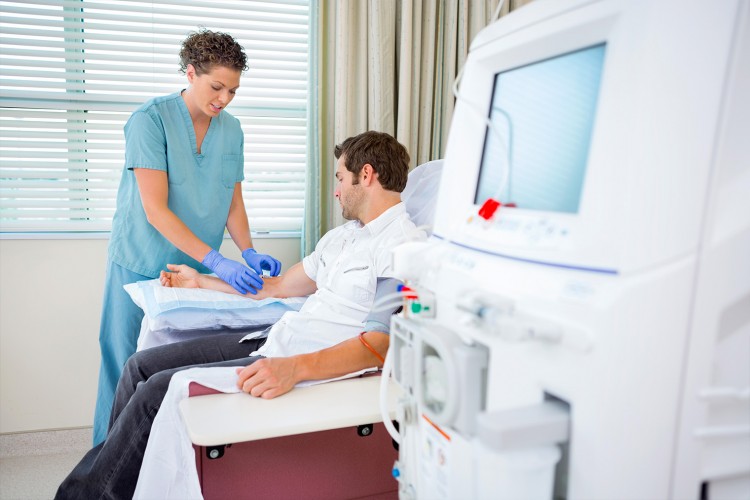
UBC Sauder research helps determine treatment plans for kidney patients across North America

Key findings by a team from the UBC Sauder School of Business are now being recommended in the treatment of kidney disease across North America and around the world.
The recommendations appear in the National Kidney Foundation’s latest clinical practice guidelines, which were also published in the American Journal of Kidney Disease.
In the human body, healthy kidneys clean blood, remove excess fluid, and produce substances that keep people healthy.
But when the kidneys start to fail, the body may need help performing those functions through dialysis — which removes waste and fluid from the body — and through hemodialysis, which uses a machine to clean the blood then returns it into the body.
More than 1.5 million kidney patients around the world require hemodialysis. In order to receive it, however, they must first be outfitted with a way to connect to the dialysis machine, and there are two methods: arteriovenous fistula (AVF) and central venous catheter (CVC).
Because of lower complication rates and better patient outcomes, AVF is the gold standard; the downside, however, is it involves a lengthy process. Through surgery, an artery is connected to a vein that returns blood to the heart; patients are then closely monitored for several months to make sure the vein matures and strengthens so it can later accept the pressure from the hemodialysis machine.
If the vein doesn’t mature properly, the process may be restarted using a different vein, which can be time-consuming — just as the need for potentially lifesaving hemodialysis is growing.
As a result, the key question becomes: when should physicians start preparing people for AVF? Do it too soon, and they could put patients through unnecessary risk and hardship, especially if they’re seniors nearing the end of life; do it too late, and patients could further suffer from the effects of their kidney disease.
“You can't just snap your fingers and have it created in a short amount of time. So that's what makes it a challenging timing decision,” says UBC Sauder School of Business Professor Steven Shechter, co-author of the study Timing of Arteriovenous Fistula Creation in Patients With CKD: A Decision Analysis.
“If someone is progressing and their kidney function is deteriorating, but they're not yet needing hemodialysis, when do you pull the trigger and say, ‘Is now the time?’”
So Shechter and then-PhD student Reza Skandari collaborated with Dr. Nadia Zalunardo, nephrologist in the UBC Division of Nephrology and Medical Director of Vancouver General Hospital’s Kidney Clinic, to devise recommendations.
The key, says Shechter, was to avoid a “one size fits all” approach, and to employ modelling to create a more tailored spectrum of recommendations, ones that factor in age and other risk categories.
“If you're older, maybe you can wait a little bit longer, because you might not end up needing hemodialysis after all. If you're younger, maybe you should be referred a little bit earlier because you have more time to take advantage of the benefits,” says Shechter. “So it’s a better range.”
Now some of those recommendations, which Shechter and his team first published in 2014, have been included in the Kidney Disease Outcomes Quality Initiative’s recently updated clinical practice guidelines.
The guidelines are produced by the New York-based National Kidney Foundation and published in the American Journal of Kidney Disease, and inform the treatment of kidney disease across the globe. The previous guidelines had been in place since 2006.
Specifically, the findings from Shechter’s team will help physicians decide exactly when to start preparing kidney patients for AVF, and will likely lead to better patient outcomes.
“I don't think anybody questions that an AVF is better for most people. But the singular focus on trying to increase the percentage of patients who get AVF misses the fact that there's this process with a whole lot of uncertainty involved in getting to the point of having a functional AVF,” says Shechter, who, along with Skandari, also just had an extension paper titled Patient Type Bayes-Adaptive Treatment Plans: The Case of Chronic Kidney Disease accepted by the flagship journal Operations Research.
“And that process, that timing and that uncertainty, in combination with whether the patient ever needs dialysis, is where our model-based approach comes into play.”
Zalunardo says the results are an excellent example of what can happen when experts in medicine and operations research collaborate.
Predicting the progression of kidney disease and knowing when is the right time to create an AVF can be very challenging, she says, and there is a dearth of randomized controlled studies in the area, so the recommendations provide essential practical guidance for those treating the condition. The fact that the research is being taken up in the literature, she adds, is especially exciting.
“They felt confident enough in our results that they’re essentially putting this out as a recommendation to nephrologists across the globe,” says Zalunardo. “And as an investigator, that feels very validating.”